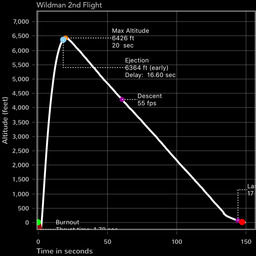   |
| Likes |  |
| Rocket | Wildman Jr |
| Launches | 1 |
| Flight Status | Success |
| Location | Palm bay, FL |
| Altitude | 6426 ft 1958.64m |
| Expected | 6150 ft 1874.52m |
| Velocity | 567 MPH 912.87km/h |
| Velocity Exp. | 572 MPH 920.92km/h |
| Gs Actual | 19.0 |
| Gs Expected | 17.0 |
| Wind Speed | 14.0MPH 22.54km/h |
| Weight | |
| Stage | Motor |
| 1 | J335-RED |
Wildman Jr- Second Flight
2018-03-10 14:18:00ZDescription
This was my first flight over a mile high. I lost sight of it in the hazy upper clouds but briefly saw it again after the main deployed. Eggfinder had a good lock and I was able to drive right to it.
For some reason my main altimeter never armed so my backup alt saved the rocket. I had no motor deploy.
I'll need to do some testing to find the cause.

















Comments
Nice flight! How'd you like the SRA field?
I loved all the open space. My only issue with it was the 3.5 hour drive from home.
I was surprised all the streets were in my GPS, made it super easy to just drive to my rocket like I was driving to someone's house.
Tested the primary altimeter today by wiring Christmas lights to the terminals and placing the e-bay into a vacuum bag. I drew a partial vacuum and the drogue light lit a second after the pump stopped and pressure started increasing, the main lit a few seconds later. I downloaded the data to analyze and it looked good.
I did several more tests and was able to duplicate what I saw in the log for this flight by arming the altimeter and and then killing power to the it a few seconds later. All the tests were done with the same battery used in the flight so that rules out a bad battery and all connections were still secure.
The most likely cause was a screw switch that was not tightened down good. I used a different screw driver at the launch than I normally use to test and prep. It had a shaft that was the same diameter as the vent hole I align with the switch. I think this caused the screw driver to bind a little and made me think I torqued the screw on the switch more than I really did.
I'm not a fan of screw switches. I had them on my Nutcracker due to all the positive feedback about them online. I even had this configuration for its 27k flight in Colorado. My experience was intermittent ON while screwing in until ON. These types of brown outs are really bad for electronics and I could see a scenario where they set off pyro at the pad from the electronics getting in a bad state. What's more, you may not have it all the way screwed in, but think you do, and with intermittent on, it could be on until launch shakes it OFF.
I would rather use Gary's method of just twisting the wires together than using screw switches.
I have seen instructions on publicmissles where they use a standard off/on switch. I'd trust that if mounted sideways (thus no effect from positive of negative Gs). In their instructions, they just have ON facing the AFT, but my fear is major negative Gs during deceleration from Mach+ or ejection charge could rattle it off.
My favored method is a simple heavy duty 120 volt push button switch mounted sideways so Gs have no effect.
Thanks for the feedback. Based on this experience, I'm going to phase out using screw switches on single altimeter configurations. I'll still use them in redundant configs but only when a different type of switch is used to arm the second altimeter.
I'll be paying more attention to making sure the screw is tight on future flights and may reconsider their use again if no additional failures are seen. I'm also going to shop around for hex head or Torx screws to replace the Phillips heads that come with these switches. Something that provide a more positive engagement between the screw and driver should help.